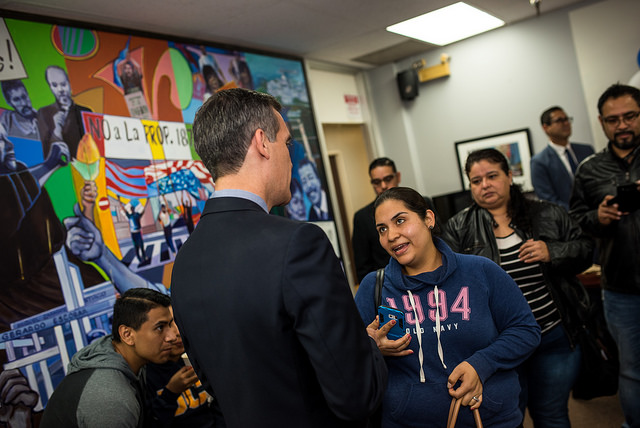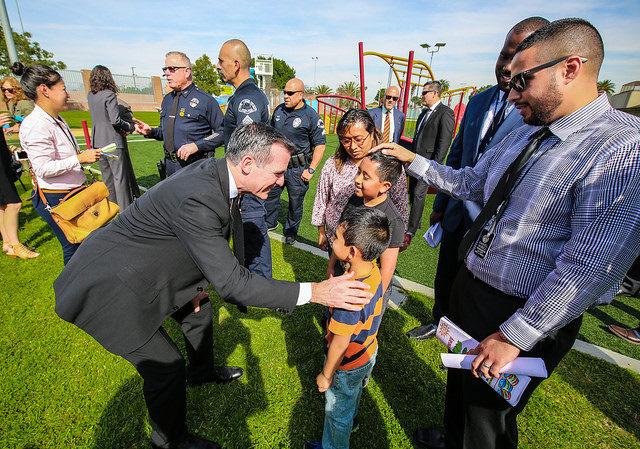*This blog post is part two of a four-part blog series dedicated to the topic of sanctuary cities.
In part one of this blog series, discussion centered on the meaning, history, and significance of sanctuary cities in the United States. The account is in consideration of the Executive Order: Enhancing Public Safety in the Interior of the United States (Executive Order No. 13768) signed by President Donald J. Trump in January 2017, which targets sanctuary cities. Yet, what does this executive order mean for the City of Los Angeles? What would be the public safety consequences in Los Angeles if the executive order is implemented?
With a population of more than four million people, Los Angeles is the second most populous city in the nation after New York City. There are people from approximately 140 countries that call this metropolis their home and at least 185 languages are spoken. Furthermore, according to a study from the Pew Research Center, it is estimated that there are 375,000 undocumented immigrants residing in the City of Los Angeles—this number increases to one million for the Los Angeles metro area. Thus, it is one of the most diverse cities in the United States.
In 1979, aware of the changing demographics that were taking place in Los Angeles, the Los Angeles Police Department (LAPD) adopted Special Order 40. The Special Order prohibits police officers from initiating contact with a person with the purpose of determining his or her immigration status. Special Order 40 was adopted to encourage undocumented immigrants to report crimes to the police without the fear of deportation—this as a mechanism to ensure the public safety of all Angelenos regardless of one’s legal status in the country. However, the Special Order does not protect undocumented immigrants who have been arrested for multiple misdemeanor offenses, a high-grade misdemeanor or a felony offense, or have been arrested for the same offense a second time.

Mayor Eric Garcetti showing solidarity with walk-ins at the Coalition for Humane Immigrant Rights (CHIRLA), Los Angeles, California
Following the November 2016 presidential elections, Los Angeles Mayor Eric Garcetti and LAPD Chief Charlie Beck expressed their continued commitment to uphold Special Order 40 and have Los Angeles be a safe place for everyone. In fact, in March 2017, Garcetti signed Executive Directive 20. The executive directive includes language in which it orders the City’s Fire Department, Airport Police, and Port Police to adopt policies and procedures that are consistent with LAPD’s existing immigration enforcement policies and procedures—this includes Special Order 40.
However, the executive order is an obstacle in ensuring the public safety of places like Los Angeles. This policy includes language that threatens to cut federal funding from cities that do not cooperate with federal immigration authorities by reporting undocumented immigrants, even if these individuals have not committed serious or repeated offenses. The executive order claims that sanctuary cities willfully violate federal law by protecting undocumented immigrants and has resulted in immeasurable harm to the people of the United States and the country. Therefore, the policy authorizes Attorney General Jefferson Beauregard Sessions III (Jeff Sessions) and Secretary of Homeland Security John Francis Kelly to take away federal funding from sanctuary cities, except as deemed necessary for law enforcement purposes. Given the ambiguity of the term “sanctuary city,” Garcetti and Beck—along with other mayors and law enforcement officials—have requested John F. Kelly to provide a fixed definition of what the federal government considers to be a sanctuary city.
Despite the claims made by President Trump, several studies have concluded that there is no correlation between crime rates and the levels of immigration. Both census-data driven studies and macro-level studies indicate that immigrants are less likely to commit crimes than the native-born population. In fact, some of these studies have found that a higher immigration rate contributed to a decline in certain types of crimes. One explanation for the lower criminality rates is that immigrants who commit crimes can be deported.

Mayor Garcetti announcing the new expansion of Community Safety Partnership in South Los Angeles, California
Although the executive order has not yet been fully implemented, the policy is already impacting cities like Los Angeles. Chief Beck recently indicated that there has been a drop among Latino Angelenos that are reporting domestic violence and sexual assault. Sex assault reports are down 25-percent and domestic violence claims are down 10-percent year-to-date. Beck attributes the decrease to fears of deportation from the Latino immigrant community.
President Trump argues that by signing this executive order, the public safety of our communities will be improved. However, in Los Angeles the opposite effect seems to be taking place, as there is already a decrease in reports of domestic violence and sexual assault among Latino Angelenos. Furthermore, such policies only jeopardize the existing relationship between the immigrant community and local police authorities, as it creates a climate of distrust from immigrants towards police officials. What have been the public safety benefits of declaring your community a sanctuary city? What alternative policies and practices could be adopted to improve the public safety of our communities?
*It should be noted that Mayor Eric Garcetti has refused to use the term “sanctuary city” when referring to the City of Los Angeles. He has indicated that he still is not sure what a sanctuary city is.
Credits: Images and data linked to sources.
